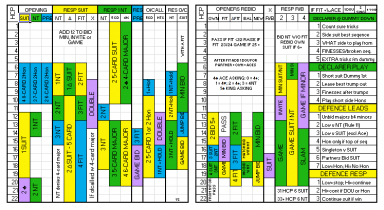- Home
- Results
- Tournaments
- WB Events
- Initiatives
- WBRC
- Resources
- Contact
- Search
WB Regional Conference
The annual Waikato-Bays Regional Conference took place at the Matamata rooms on Sunday 24th September. A goodly turn-out of representatives from 13 of the 22 clubs in the region was present with apologies from two more. We had several presentations, mostly geared at ways to maintain and increase participation in our wonderful game:
Anna Kalma reviewed the State of the Nation comparing our region to the wider NZ Bridge population. In summary:
- Our region had grown by 4% since 2013 until last year. We grew 0.5% since the last Regional Conference. We remain the second largest region by club member population.
- Solely based on home club members, 50% of our bridge members are located in 5 clubs, Tauranga, Hamilton, Mt Maunganui, Taupo and Cambridge.
- Membership growth was seen at Cambridge (32), Whakatane (27), Taupo (23), Te Aroha (18), Mt Maunganui (14), Katikati (13) and Waihi (12).
- Negative membership trend was seen at some smaller clubs but at the large clubs also.
Will Fulton of the Franklin Bridge Club recounted his experience as a new player, from his motivation to tag along to the lessons, completing the lessons to starting play and to coming across the local OTS (Old Trout Syndrome) which just about put him off playing ever again. An engaging and vivacious speaker he recalled an inspiring experience from attending a session of club play at Paul Marston’s Bridge Club in Sydney. He referred to the standard cheat sheet which he felt was too complicated and therefore created his own which will be of interest to many. He certainly gave us food for thought in regards to how to welcome and nurture the new players rather than throwing them in the deep end.

Alan Turner gave us a brief history of how the 10 bridge lessons came into existence and told us that the Teachers Committee is currently developing lessons for improvers. Alan asked feedback as to which subjects the committee should cover in these improvers lessons.
Jane Stearns gave us a passionate speech about how to enhance the experience for new members, how to welcome them and nurture them with a buddy. She also pointed out that the playing environment is the first thing new players get to see and may be putting them off from coming back. Her power point presentation can be found on the NZ Bridge and WB web sites under Resources. These are strategies designed to keep members coming back to the club.
Plenty of networking was done during an excellent lunch organized by the Matamata Bridge Club.
After lunch we saw presentations from:
Michael Spring, Immediate Past President of Bowls New Zealand, who showed us how Bowls NZ had tackled the challenge of falling membership by changing what they have to offer. Amongst other things, they now try to cater for the baby boomers, generation X and Y and are now looking at the Millennials by offering all (so not needing to become a member of a bowling club) to have one-off games where they can hire bowling gear, be shown quickly how to bowl and have a game called “Jack Attack”, usually followed by a trip to the bar. It had increased the revenue of the clubs considerably as bowling was made attractive to work functions, team building exercises etc.
He pointed out that Bowls NZ had gone into partnership with “Strong and Sustainable Clubs” which were resourced to host these kind of activities and these clubs were checked with a kind of WOF. Bowls NZ have set up Community Development Officers in order to support the bowling clubs.
Michael also pointed out the seven drivers to club satisfaction
- Decent Facilities
- Great Coaches
- Good Communications
- Good Social Environment
- Professionalism and Expertise
- Friendly and Welcoming
- Fulfilling Potential
Bowls is trying very hard to shake the “old people’s game” image.
Clare Coles told us that the current Board is a happy one and that the communications between Board and clubs/players was regular. There is no secrecy in the Board and there had not been “in committee” meetings. Clare also pointed out the main points of a three year Strategic Plan. The strategic plan was not started with a blank piece of paper, as in recent years some work was done and published in the Arrowside report, the consultancy report from Allan Morris and Stephen Henry, and the previous board's strategic plan.
Amongst some questions from the floor was the radio advertising campaign. This was received with mixed enthusiasm. Some clubs would do it again, perhaps at a different radio station and one club was dead against it.
In closing Rona reminded us that next week is another important meeting, namely the NZB Bridge AGM at 9:00 on Saturday at the start of Congress. She urged the clubs to send representatives.





















